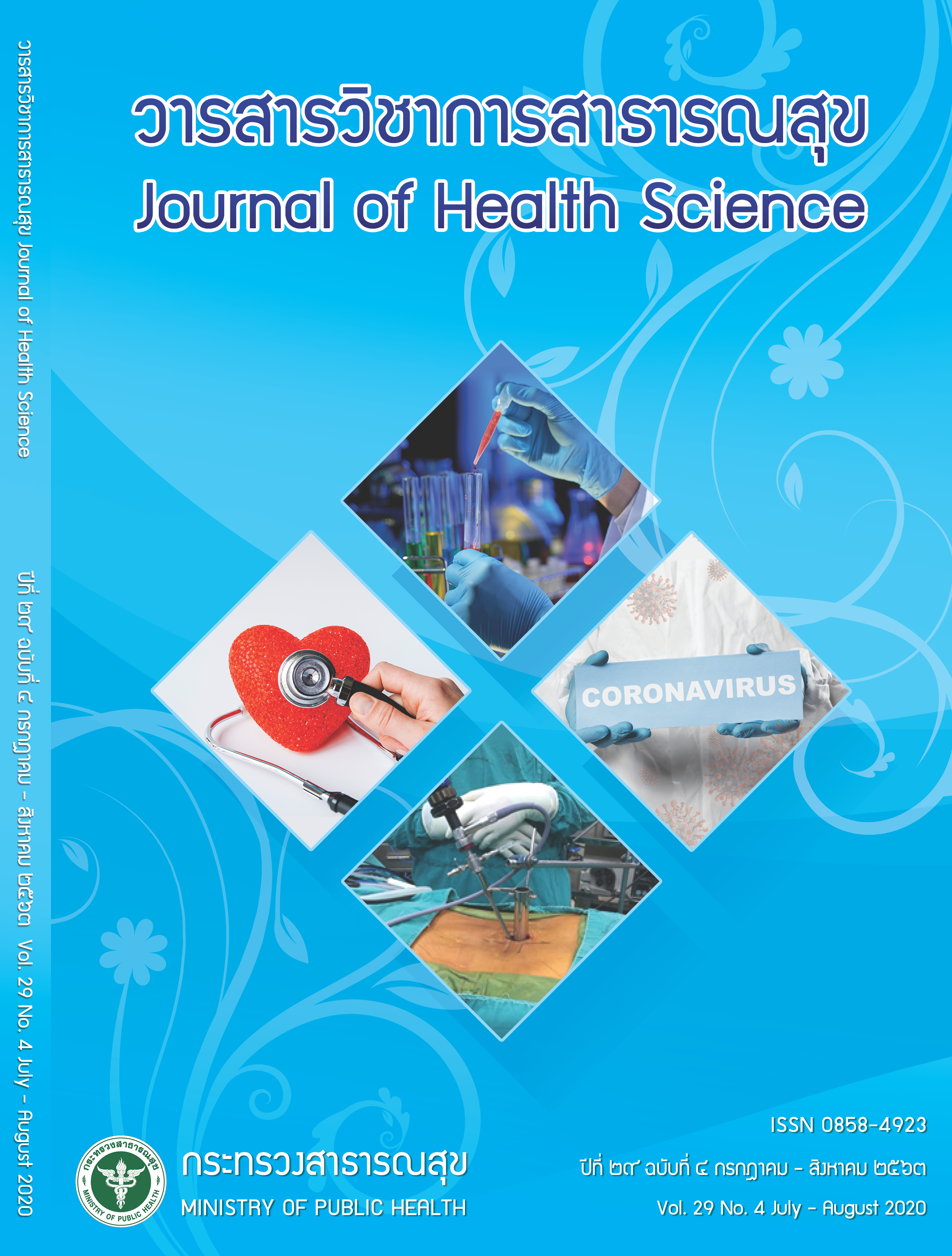ผลการรักษาหมอนรองกระดูกทับเส้นประสาทด้วยอุปกรณ์ผ่าตัดกระดูกสันหลังแบบแผลเล็กโรงพยาบาล เชียงรายประชานุเคราะห์
คำสำคัญ:
หมอนรองกระดูกทับเส้นประสาท, อุปกรณ์กล้องผ่าตัดกระดูกสันหลังแบบแผลเล็ก, วิธีการผ่าตัดกระดูกสันหลังแบบแผลเล็กบทคัดย่อ
ปัจจุบันการผ่าตัดรักษาภาวะหมอนรองกระดูกทับเส้นประสาทด้วยวิธีผ่าตัดแบบแผลเล็กเป็นที่ยอมรับมากขึ้นมีผลการรักษาไม่แตกต่างจากการผ่าตัดแบบมาตรฐานดั้งเดิมและมีข้อดีในแง่ลดการเสียเลือดจากการผ่าตัด เนื้อเยื่อบาดเจ็บน้อยลง ลดวันนอนโรงพยาบาล การศึกษานี้มีวัตถุประสงค์เพื่อรายงานผลการรักษาภาวะหมอนรองกระดูกทับเส้นประสาท ด้วยอุปกรณ์ที่พัฒนาขึ้นเองสำหรับผ่าตัดกระดูกสันหลังแบบแผลเล็กโรงพยาบาลเชียงรายประชานุเคราะห์ (Arthroscopic-tubular retractor system: Chiang Rai system) ศึกษาย้อนหลังในผู้ป่ วยโรคหมอนรองกระดูกทับเส้นประสาท อายุ 18 ปีขึ้นไปในโรงพยาบาลเชียงรายประชานุเคราะห์ ระหว่างเดือน พฤษภาคม 2559 – กุมภาพันธ์ 2562 ก่อนผ่าและหลังผ่าเปรียบเทียบคะแนนความเจ็บปวด (numeric pain rating scale) แบบทดสอบ Owestry disability index (ODI) วัดความรุนแรงและการจำกัดกิจวัตรประจำวันจากอาการปวดหลังร้าวลงขา และความพึงพอใจหลังการรักษา (modified Macnab criteria) เมื่อแรกรับ 1 เดือน 6 เดือน 12 เดือน และ24 เดือน หลังผ่าตัด ผลการศึกษาพบว่า ผู้ป่ วยได้รับการผ่าตัดด้วยอุปกรณ์ชุดนี้จำนวน 30 ราย (เพศชาย 16 ราย เพศหญิง 14 ราย) ใช้เวลาในการผ่าตัดเฉลี่ย 134.5 นาที การสูญเสียเลือดระหว่างผ่าตัดเฉลี่ย 75.7 ml. ระยะ เวลาในการนอนโรงพยาบาลเฉลี่ย 2.4 วัน ผลการผ่าตัดผู้ป่ วยด้วยอุปกรณ์ผ่าตัดแบบแผลเล็ก พบว่า คะแนนการปวด ทั้งบริเวณหลัง และปวดร้าวลงขา ลดลงตั้งแต่หลังผ่าตัดเดือนแรก (ปวดหลัง 6.7 ลดลงเหลือ 1.5, ปวดร้าวลงขา 8.4 ลดลงเหลือ 0.9) ผู้ป่ วยมีความพึงพอใจในการรักษาอยู่ในเกณฑ์ดีเยี่ยมถึงดี ร้อยละ 86.6 อุปกรณ์ผ่าตัดนี้ สามารถนำมาประยุกต์ใช้ในการผ่าตัดได้โดยมีผลการรักษาที่น่าพอใจ อย่างไรก็ตาม การศึกษานี้มีข้อจำกัดในประเด็นของจำนวนกลุ่มตัวอย่างที่ทำการศึกษายังมีจำนวนน้อย จึงต้องมีการเก็บรวบรวมข้อมูลผลการรักษาต่อไป เพื่อประเมินและพัฒนาการใช้งานอุปกรณ์ชุดนี้ต่อไป
Downloads
เอกสารอ้างอิง
Annertz M, Jonsson B, Stromqvist B, Holtas S. No re-lationship between epidural fibrosis and sciatica in the lumbar post discectomy syndrome. A study with con-trast-enhanced magnetic resonance imaging in symptom-atic and asymptomatic patients. Spine 1995;20(4): 449-53.
Fritsch EW, Heisel J, Rupp S. The failed back surgery syndrome: reasons, intraoperative findings, and long-term results: a report of 182 operative treatments. Spine 1996; 21(5):626-33.
Schoeggl A, Maier H, Saringer W, Reddy M, Matula C. Outcome after chronic sciatica as the only reason for lumbar microdiscectomy. J Spinal Disord Tech 2002; 15(5):415-9.
Dewing CB, Provencher MT, Riffenburgh RH, Kerr S, Manos RE. The outcomes of lumbar microdiscectomy in a young, active population: correlation by herniation type and level. Spine 2008;33(1):33-8.
Goald HJ. Microlumbar discectomy: follow-up of 477 patients. J Microsurg 1980;2(2):95-100.
Katayama Y, Matsuyama Y, Yoshihara H, Sakai Y, Nakamura H, Nakashima S, et al. Comparison of surgi-cal outcomes between macro discectomy and micro discectomy for lumbar disc herniation: a prospective randomized study with surgery performed by the same spine surgeon. J Spinal Disord Tech 2006;19(5):344-7.
Perez-Cruet MJ, Foley KT, Isaacs RE, Rice-Wyllie L, Wellington R, Smith MM, et al. Microendoscopic lumbar discectomy: technical note. Neurosurgery 2002; 51(5):S129–36.
Foley KT, Smith MM. Microendoscopic discectomy. Tech Neurosurg 1997;3:301–7.
Nopawan Sanjaroensuttikul. The Oswestry Low Back Pain Disability Questionnaire (Version 1.0) Thai Version. J Med Assoc Thai 2007;90(7):1417-22.
Macnab I. Negative disc exploration: an analysis of the cause of nerve root involvement in sixty-eight patients. J Bone Joint Surg Am 1971;53(5):891-903.
Mu X, Wei J, Li P. What were the advantages of mi-croendoscopic discectomy for lumbar disc herniation comparing with open discectomy: a meta-analysis? Int J Clin Exp Med 2015;8(10):17498-506.
Harrington JF, French P. Open versus minimally invasive lumbar microdiscectomy: comparison of operative times, length of hospital stay, narcotic use and complications. Minim Invasive Neurosurg 2008;51(1):30-5.
Patil A, Chugh A, Gotecha S, Kotecha M, Punia P, Ashok A, et al. Microendoscopic discectomy for lumbar disc herniations. J Craniovertebr Junction Spine 2018; 9(3):156-62.
Tait MJ, Levy J, Nowell M, Pocock C, Petrik V, Bell BA, et al. Improved outcome after lumbar microdiscec-tomy in patients shown their excised disc fragments: A prospective, double blind, randomised, controlled trial. J Neurol Neurosurg Psychiatry 2009;80(9):1044–6.
Katayama Y, Matsuyama Y, Yoshihara H, Sakai Y, Nakamura H, Nakashima S, et al. Comparison of surgi-cal outcomes between macro discectomy and micro discectomy for lumbar disc herniation: a prospective randomized study with surgery performed by the same spine surgeon. J Spinal Disord Tech 2006;19(5): 344–7.
McGirt MJ, Ambrossi GL, Datoo G, Sciubba DM, With-am TF, Wolinsky JP, et al. Recurrent disc herniation and long term back pain after primary lumbar discectomy: Review of outcomes reported for limited versus aggres-sive disc removal. Neurosurgery. 2009; 64(2): 338–44.
Wu X, Zhuang S, Mao Z, Chen H. Microendoscopic discectomy for lumbar disc herniation: surgical technique and outcome in 873 consecutive cases. Spine 2006; 31(23):2689-94.
Zhao LJ , Jiang WY, Ma WH, Xu RM, Sun SH. Mi-cro-endoscopic discectomy for the treatment of lumbar disc herniation in senile patients over seventy years old.Zhongguo Gu Shang 2011;24(10):811-5.
Nakagawa Y, Yoshida M, Maia K. Microendoscopic discectomy (MED) for surgical management of lumbar disc disease: technical note. Internet Journal of Spine Surgery 2005;2(2):1-7.
Zhang C, Zhou Y, Chu TW. Traumatic responses fol-lowing microendoscopic discectomy: clinical analysis of 44 patients. Zhonghua Yi Xue Za Zhi 2006; 86(43): 3039-42.
Kodeeswaran M, Ranganathan J, Sherina PR. Microen-doscopic discectomy (MED) for lumbar disc herniation: comparison of learning curve of the surgery and outcome with other established case studies. J Spine Surg 2018; 4(3):630–7.
Shriver MF, Xie JJ, Tye EY, Rosenbaum BP, Kshettry VR, Benzel EC, et al. Lumbar microdiscectomy compli-cation rates: a systematic review and meta-analysis. Neurosurg Focus 2015;39(4):1-11.
ดาวน์โหลด
เผยแพร่แล้ว
วิธีการอ้างอิง
ฉบับ
บท
การอนุญาต

This work is licensed under a Creative Commons Attribution-NonCommercial-NoDerivatives 4.0 International License.







